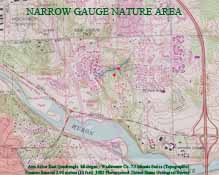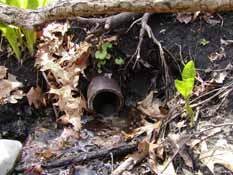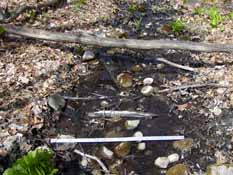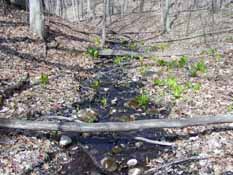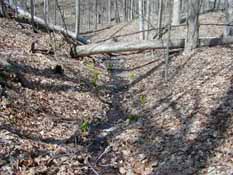The Peter G. Meier Water Quality Survey
Narrow Gauge Way Nature Area: Storm Drain Spring Rivulet
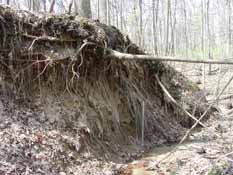
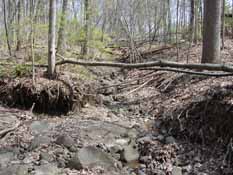
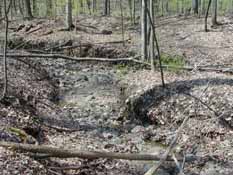
STORM DRAIN AND SPRING RIVULET:
NARROW GAUGE WAY NATURE AREA:
GENERAL COMMENTS
Hannah-Maria Jacques
jacques@umich.edu
Narrow Gauge Way Nature Area is situated on steep morainic terrain south of Green Road, Ann Arbor, Michigan. Forest cover is mostly oak and maple. There are isolated stands of hemlock in the valleys.
The largest of the preserve's water courses flows from east to west and is primarily a stormwater drain. When I first collected at the nature area, 23 March 2010, there was minimal flow in the main channel of the drain and no observable flow in the southeast branch of the drain.
During periods of rainfall, however, the storm drain becomes a raging torrent, as evidenced by severe erosion shown in Figures 1, 2 and 3. Note the meter stick in Figure 1.
Because of the scouring action of the rainwater, to say nothing of any road oil or other non-point source pollution, the drain environment is highly stressed. There are very few taxa present and none that are considered to be sensitive to physico-chemical disturbances.
Of the six insect taxa found in the benthic samples taken from the drain, three are not truly aquatic: the ground beetle (Carabidae) and the water scavenger beetle (Hydrophilidae) of the terrestrial subfamily Sphaeridiinae, are more associated with the moist environment adjacent to the drain than to the aquatic milieu per se; and springtails are only aquatic in the sense that they inhabit the surface film of the water or may live approximate to bodies of water.
The spring rivulet that flows about 100 meters from the south to the main drain is rich in macroinvertebrates and serves as a dramatic counterpoint to the virtually barren condition of the drain. Comparison of the spring rivulet and the main drain at their confluence serves to demonstrate the impact of stress on a natural environment in general and on water quality in particular. The spring rivulet constitutes an oasis of aquatic life adjacent to a stream that has been scoured of almost all life.
To date, I have sampled the spring rivulet twice, 23 March 2010, and 10 April 2010.
The spring rivulet is the only place in Ann Arbor that I have collected the nemourid broadback stonefly, and one of the few places I have found the lepidostomatid case maker caddisfly. The spring is also rich in beetle and fly species. Of the 10 taxa collected, 2 were beetles and 4 were flies. An additional beetle and several flies collected from the spring rivulet in April remain to be identified.
This fall we shall conduct further sampling of the streams in the Narrow Gauge Way Nature Area, and our comments and an analysis of the streams based on both spring and fall sampling will be posted late this fall or during the winter.
20 August 2010
